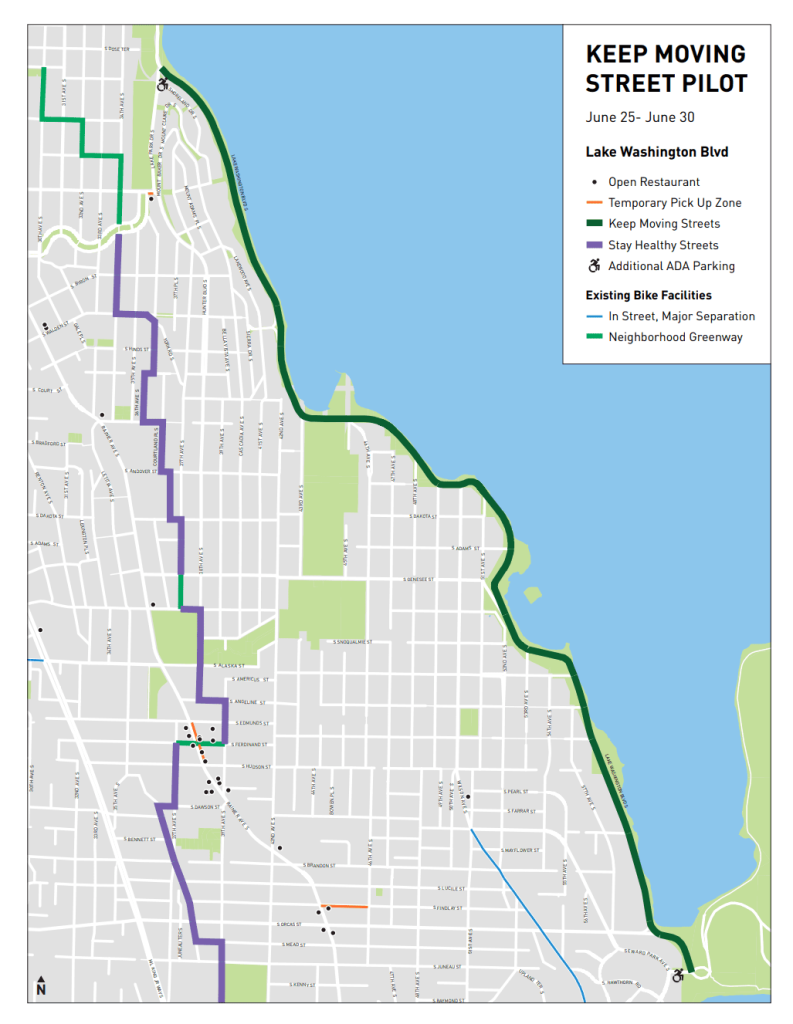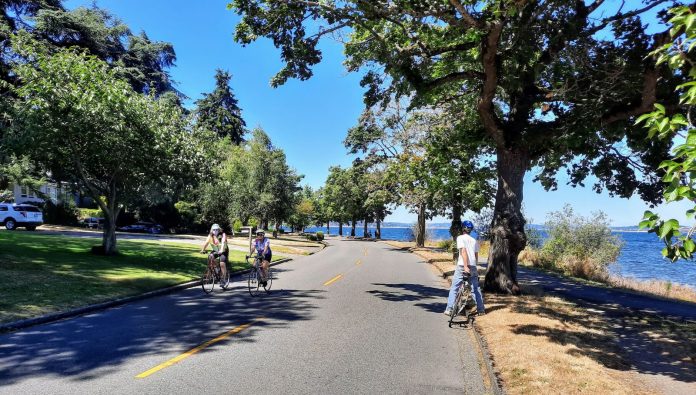The Seattle Department of Transportation (SDOT) is loosing the cars on Lake Washington Boulevard on Monday, but it should stay an open street permanently dedicated to people walking, rolling, and biking.
Lake Washington Boulevard has proved a popular biking and pedestrian route after ten weeks as an open street, but–despite this success–SDOT is shutting it down and letting cars rule once more. In a tweet, the agency has teased re-opening the street to people walking, rolling, scooting, and biking for one long weekend per month, advocates are asking for more. Seattle Neighborhood Greenways started a petition asking the City to keep the program going every weekend through the winter and spring. It quickly gained more than 300 signatures.
The “Keep It Moving Street,” as SDOT and Seattle Parks branded it, has been in place since July 24th on a three-mile stretch of Lake Washington Boulevard from Mount Baker Beach to Seward Park. Among more than a dozen open streets SDOT initiated across the City in response to Covid, Lake Washington Boulevard stood out as the most popular with Seattleites of all ages and abilities. Kids are learning how to bike on a boulevard otherwise known for burn cruises and rich people revving their oversized sports car engines.
Due to this smashing success, we implore SDOT and the Mayor to make the open street on Lake Washington Boulevard permanent. We count four reasons why.
First off, the open street returns Lake Washington Boulevard to its historic use and designed purpose. The Olmsted brothers designed the boulevard as a linear park for people walking, biking, and picnicking. It wasn’t designed as a motor speedway. It was intended to be one of Seattle’s signature places to relax, bike, and stroll. Car traffic has detracted from that.

Secondly, it’s a key bike route serving underserved Southeast Seattle. Lake Washington Boulevard provides a safe and flat bike route connecting to the rest of the bike network in a quadrant of the city sorely lacking such connections. The Seattle Bike Advisory Board, Cascade Bicycle Club, Seattle Greenways, Seattle Bike Blog, and just about any other group of advocates out there have identified safe bike routes in Southeast Seattle as their highest priority.
Lake Washington Boulevard helps rectify this, and it connects to the Mountains-to-Sound Greenway, which would provide an all Ages, Languages, Ethnicities, Genders, Races and Abilities (ALEGRA) bike route into the downtown core and Judkins Park Station, Seattle’s new light rail station on the soon to open East Link. Improving bike access and safety in Southeast Seattle will take more than just a car-free Lake Washington Boulevard. But losing this route is going in exactly the wrong direction.
Thirdly, physical distancing is really challenging on this corridor without the open street. Sidewalks are narrow and bike and foot traffic is high along the boulevard. Without the open street, people struggle to keep six feet apart and may not feel safe being there at all.
Finally, cities that are truly walkable and bikeable don’t stop and pack it up in the winter. Seattle’s climate isn’t all that different in Copenhagen–arguably the most bikeable city in the world–and yet Copenhagen doesn’t dismantle its bike facilities in the winter. They stay in place and people keep on biking. If Seattle wants to have a world class transportation system, it’s going to have to follow suit. Making it permanent also allows SDOT to improve traffic diverters and signage and save on the hassle and cost of tearing them down and putting them back up. Simpler to make it a fixture of the boulevard.
Take action: We encourage you to sign the Seattle Greenways petition asking for the open street to stay on weekends and email Mayor Jenny Durkan to make it permanent.
The editorial board consists of Natalie Bicknell, Ryan Packer, and Doug Trumm.
The Urbanist was founded in 2014 to examine and influence urban policies. We believe cities provide unique opportunities for addressing many of the most challenging social, environmental, and economic problems. We serve as a resource for promoting and disseminating ideas, creating community, increasing political participation, and improving the places we live.


